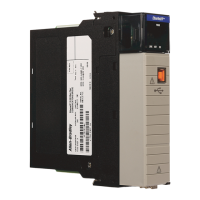28 Rockwell Automation Publication 1756-UM004D-EN-P - August 2022
Chapter 3 Connect Redundant EtherNet/IP Adapters
Redundant System
Components
The following features are supported with the 1756-EN4TR redundant adapter
pair in firmware revision 4.001 or later:
•PRP
The following features are not currently supported with the 1756-EN4TR
redundant adapter pair.
•CIP Safety™ modules
• CIP Security™
Redundant adapters can be used with redundant controllers or one controller.
For more information on redundancy, see:
• ControlLogix® 5570 Redundancy User Manual, publication 1756-UM535
• ControlLogix 5580 Redundant Controller User Manual,
publication 1756-UM015
Redundant Switchovers During redundant adapter operation, if certain conditions occur to the
primary adapter, control is switched to the secondary adapter. These
conditions cause a switchover:
• Major fault/assert on the adapter
• Failure of the adapter
• Removal of the adapter
• A program-prompted command to switchover
• An AOP-prompted command to switchover
• The adapter loses both Ethernet links
Switchover Considerations
Each 1756-EN4TR adapter uses one IP address as the primary IP address for all
communication on the EtherNet/IP™ network. The redundant adapter pair
consists of one active and one stand-by adapter.
The two adapters negotiate which is the primary, depending on the status of
the system. If the primary adapter is unable to perform its role, for example, if
a fault occurs in the primary adapter, then the secondary adapter becomes the
new primary, assuming the IP address of the first primary adapter and taking
over the role of communication. The primary adapter is the only adapter of the
pair that produces data on the EtherNet/IP network.
On power-up, the primary is chosen from a pair of devices. The secondary
adapter uses the primary IP address +1. For example, if the primary adapter
has an IP address of ‘N’, then the secondary adapter has an IP address of ‘N+1’.
The primary adapter is always active and is responsible for monitoring all
inputs and outputs, monitoring diagnostics in the system, and reading and
writing data to and from I/O simultaneously. The secondary adapter is waiting
to take over communication, if the primary switches over.
If there is a switchover, the IP address swapping between the primary adapter
and the secondary adapter takes no longer than 50 ms from the time of the
initiating fault. The secondary adapter is the new primary and handles all
communication. Depending on the RPIs configured, the observed switchover
time can appear longer. Transmission time that is imposed by network
infrastructure has to be considered when calculating overall switchover time.
No connection drops occur during this switchover process.

